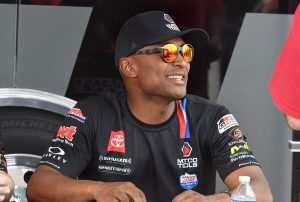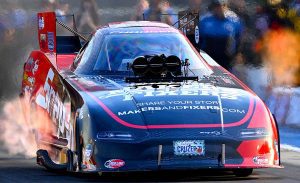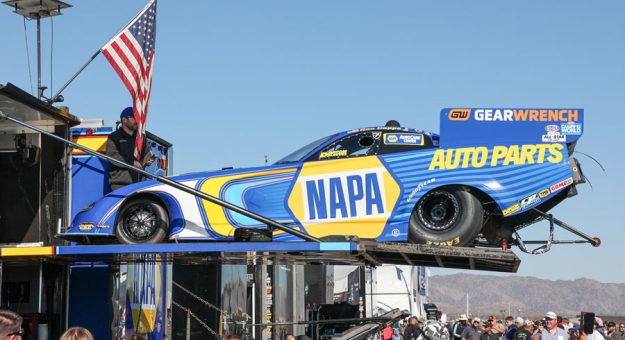The cost cap in Formula 1 this year is $140 million. To operate a NASCAR team for a single season costs about $15 million. A top-tier IndyCar team’s expenses for a full schedule run about $10 million.
A first-class NHRA Top Fuel or Funny Car team takes about $3 million to $4 million a year to field. In some ways, comparing the series is an apples-to-oranges exercise. However, it’s insightful to compare in certain aspects.
And it appears someone wanting to become involved in motorsports can have a competitive, elite drag-racing team for about $3 million.
Celebrities such as Michael Jordan, Floyd Mayweather, Pitbull and Troy Aikman have gravitated to NASCAR team ownership. David Letterman, Paul Newman, Cedric The Entertainer, Walter Payton and Jim Harbaugh have invested in IndyCar teams.
Plenty of rock stars (Bruce Springsteen, Billy Gibbons, Steven Tyler, Gene Simmons, Paul Stanley, Tommy Lee and Carlos Santana) have attended and enjoyed drag racing, some many times, but none of them have taken steps to finance a nitro team.
Clearly the loudest, quickest, fastest, most viscerally spectacular sport on the planet, drag racing also would appear to be a bargain.
So why is a platform that appeals to at least 78.5 million consumers and captures the extreme and immediate-gratification essence of modern-day America — in Top Fuel team owner-driver Antron Brown’s words — “that little best-kept secret?”
Is owning a top-drawer drag-racing operation worth it?
Brown, who spent a year under boss Don Schumacher’s tutelage then another because of the pandemic before taking the reins on his own, said, “I look, overall, where our sport is heading, the potential it has and the growth that it has.”
And he said it “absolutely” is worth it.

Veteran Funny Car driver and new team owner Ron Capps has encountered few pitfalls on or off the track in this first year as the master of his own destiny. And he said he owes that to acquiring a savvy attorney — not simply for obvious matters but also to understand how to study the landscape from a business perspective.
And Cruz Pedregon has been his own boss for more than 20 years, forming his approach by putting sound business principles into practice. He knows a budget that will make him competitive is not pocket change.
But he said, “I try not to worry about it too much.
“Imagine a business where you might blow the roof off your building and have to replace not only the roof but everything,” Pedregon said. “Drag racing, auto racing in general, is probably the toughest. You don’t know where you’re going to have that pile-up on the track or a guy feeds you a wheel and all of a sudden, you’re replacing a chassis or a complete car.
“The way the budget works is you keep fresh parts in the car, it treats you right and doesn’t blow up. And you have good, quality people working on it. We’ve spent money up front so that we don’t have those surprise budget craters later on,” he said.
“As a business owner, you have to have reserve built in, and you have to take good with the bad. Sometimes we get a little bump and you go extra rounds or you have a good, economical car that we’re not throwing parts at and it doesn’t blow up. You have to build in a little reserve, and you’ve got tap into that reserve,” Pedregon continued. “You keep feeding the business and it’ll come back to you.
“Everybody’s budgets are all over the place. There are some guys that live high on the hog and some guys that do the right thing and invest (the profits) in their car. And I’m one of those guys,” he said. “I have a good sponsor, but I also don’t live lavishly. I don’t have houses in different locations. I put in what I think the operation deserves. That’s why we’re in the top five in points.”
Pedregon becomes annoyed with hand-wringing counterparts.
“I listen to other owners and I’m not going to mention any names, but I don’t think it’s in the public’s best interest to bellyache or worry about budgets and ‘Oh, my God — it’s doom and gloom,’” Pedregon said. “If you can’t afford to race, owners, stay the hell home. The fans want to see a good show. Burn that nitro. We’re running the car balls to the wall, full-tilt every run. We’ll let the chips fall where they may. I’ve got a little bank account I may have to tap into. But, hey, we’re out there to race and have a good time and really give the sponsors their money’s worth.”
Pedregon has the compartmentalized owner and driver mentalities in perspective.
Capps said he is learning it, with Brown serving as moral support.
Capps wrote in his Autoweek blog, “Fans have always wondered, ‘What does it really cost to do this or do that? What does it really cost to make one run in one of these nitro cars?’ You hear all these different numbers throughout the years, and you’ve been told certain numbers. I’m learning a little more on that side of it, but on some level you don’t want to. As a driver — and I made the mistake at Phoenix — you can’t let all that stuff get into (your) head as a driver. You can’t be clouded and then go out and have your best reaction time, drive the best you can drive, with all those thoughts going on in your head.”
Likewise, he said, he needs to make a habit of ignoring financial and political trends (such as the prices and availability of the nitromethane that fuels his race car or the geopolitical factors that might or might not affect the bottom line of his budget) — when it’s time to hit the track and compete. He said he’s trying to focus on driving when he’s driving and leave the owner/sanctioning body negotiations and discussions to the boardroom.

Capps tries to minimize the negative vibes that can creep into his daily business.
“I’ll call Antron and we’ll chat because we’re both sort of in the same boat,” Capps said. “We understand what all the negatives are, but we also have people around us that will give us the positives and encourage us. They’ll tell us what we’ve got to be careful of, but at the same time not to make it sound like the sky’s falling.”
Brown sees that the sport is “evolving. Over the last 12 years, you saw the megateam deal, where you’ve got to be part of a megateam — be part of a team that has three or four or more cars — to be competitive and win races. Now, I believe it’s getting into that era where you want a tight-knit race-team family, where you keep the same guys together for five to seven years so you can actually build a dynasty.
“The big teams, they’ve been at a disadvantage for a long, long time. These small teams are able to do a lot more, because they’re doing it with quality over quantity,” Brown added. “I think that’s what you’re seeing right now. And for drag racing, I see it (as a) whole new pendulum (swing).”
From an insider’s viewpoint, owning a nitro team is desirable. But what about from an outsider’s evaluation?
Comparing the markets, the number of races in each series, the fans, the fan experience, diversity, room for growth, the metrics for fan loyalty to sponsor brands and levels of social-media engagement, the NHRA Camping World Drag Racing Series has advantages in the industry.
Offering by far a more fan-engaging experience, drag racing has its “every ticket is a pit pass” policy. That does more than give fans unparalleled access to drivers, which in turn gives corporate investors the industry’s farthest-reaching 10-month, coast-to-coast marketing vehicle. The fully integrated marketing format allows companies to reach well-educated, highly brand-loyal consumers.
“Our sport has a different dynamic than every (other) form of motorsports,” Brown said. “We actually have great B2B. Companies can come out and rub elbows with a lot of other companies. We can actually give them a direct return on their investment, in their pockets, by aligning them with our other partner and the other partners that are out there in our sport.”
“The bang-for-the-buck thing is not for me to answer,” Pedregon said. “I can talk about Snap-on. We have a lot of great customers and franchisees that are involved with drag racing, not only supporting us, but we also have a hospitality (platform) where they all bring their customers and all their people to have a good time.”
Brown said, “We can get it out there more. I think we can be more vocal on that end. The more these companies know that, it won’t be ‘that little best-kept secret.’”
